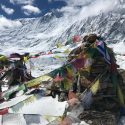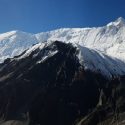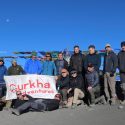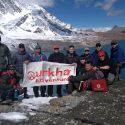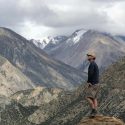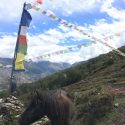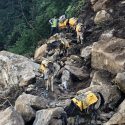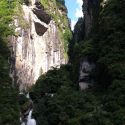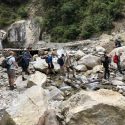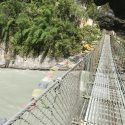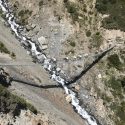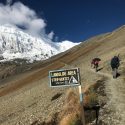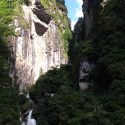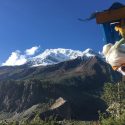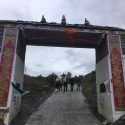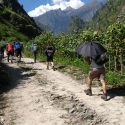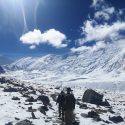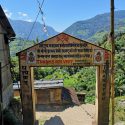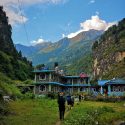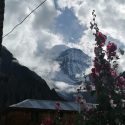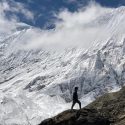As part of the 2018 training year, eleven members of 3rd Battalion the Royal Welsh were lucky enough to have the opportunity to participate in adventure training in the Himalaya of Nepal and the Annapurna Circuit.
We departed from Heathrow in the early hours of Friday 14th of September and arrived in the City of Kathmandu some 24 hours later. We were met by our guides for the trip, Khil, Man and Kirin from Gurkha Adventures who presented us all with a scarf each and a warm welcome. No sooner had the last scarf been handed out, our baggage had been taken and loaded onto our vehicles that were waiting outside for our departure, we were off to an area of the city called Tamil. We would stay at Tamil for the next two days for acclimatisation purposes. These next two days were filled with safety briefs for the arduous journey ahead and final kit preparations to ensure that our mountain trek would go without any issues. Whilst in Tamil we had the opportunity to visit The Great Buddha Stupa, which is at least 16 centuries old, also, the opportunity to see many more hidden parts of an antient civilisation by visiting some of Tamil’s many tourist sights and ancient temples.
The streets of the city were jam packed with the local population hustling to make a living by selling everything and anything they could. The traffic in the area was chaotic to say the least, but there did seem to be some strange understanding between drivers and pedestrians that led to a sort of ‘organised chaos’. The Tamil area was beautiful and teaming with culture but we were eager to move on to the next leg of our journey.
We moved via bus through some of the most beautiful mountain scenery the group had ever seen to a place called Besisahar, close to the start of the trekking. Besisahar was a small rural village with friendly locals and a much more relaxed environment than that of the beautiful chaos of Tamil. Stepping off the Bus at Besisahar was when we had our first view of the impressive snow-capped mountain ranges, but by this point bad weather had rolled over the peaks and was now obstructing a clear picture of perfection, well for now anyway.
The next morning, we awoke to clear skies and a crystal-clear view of the impressive and humbling snow-capped peaks of the mountain range surrounding us, at this point it was clear that the task ahead would be extremely challenging but also rewarding. After a quick breakfast of apple pancakes and honey porridge we set off on a short but eventful bus journey through the local area to our starting point at Ngadi, besides a huge hydro-dam built by the Chinese many years before. Now we had a good view of the terrain that lay ahead which was weirdly described by one of the group “Nepal looks just like an egg box” referring to the mountainous terrain. Or as a well-known saying amongst the guides goes:
“The trek is a little bit up, then a little bit down, then up some more.”
We followed the narrow winding trails through the forest valleys which hugged the fiercely fast flowing river. The temperature reaching 30 degrees in the midday sun. Umbrellas deployed. A vital piece of kit.
The group made good progress at the lower altitudes but took extreme caution when tackling the many obstacles that we encountered along the way, landslides caused by the monsoon season, steel wire suspension bridges, water run offs and also the local wildlife Yak, cows and donkeys who also shared the narrow trails. Our path took us through the rural villages of Jagat, Chamje, Dharapani, Chame, Pisang and finally Manang at 3519m. We were careful to spend time acclimatizing to prevent the onset of acute mountain sickness (AMS) and rested up each evening in the many tea houses along the trail which surprisingly had wi-fi and some even hot showers.
The next morning we woke fully rested, belly full of Dhal Bhatt, apple pancakes and porridge we set off for Tilicho Lake 4960m. The trek was arduous but the pace was spot on, apart from a few mild headaches the group reached the lake with no problems and we were instantly rewarded with spectacular views of the world`s highest non-freezing lake. The temperatures at the lake were a lot colder and after the group had taken in the picturesque views we made our descent back to Tilicho Base Camp where we would spend the night before heading on to Yak Kharka the next morning.
The trek to Yak Kharka was impressive, passing through an old abandoned village before stopping briefly for some lunch, that gave us another spectacular view looking back down on Manang. We reached Yak Kharka around midday where we checked into the Hotel Gangapurna and were served a delicious dinner “yak burger” and retired early for the evening.
At 0745 the following day we stepped off for The Thorong La Base Camp 4540m arriving roughly 3hrs later and here we would spend the night before the final accent over the Thorong La Pass. As far as we were all concerned, the Thorong La pass would be the pinnacle of the trek and we were all excited and somewhat nervous for the climb ahead. We had all come so far and no one wanted to get taken off the mountain with AMS, but that was not the case. When we woke at 0300 there was a good buzz in the camp and everyone was excited for the day`s task. We set off in the pitch black of the early morning with only the glow from our head torches to guide the way on our final ascent up the narrow winding path taking care not put a foot out of place. As we reached the half way point the sun rose to light the path ahead. We were nearing the summit with no signs of AMS. The air was thin but the pace was good, finally we caught sight of the prayer flags and could hear some cheers from the summit where other groups had just arrived. We had made it and were greeted with a rewarding 360 degree view of the summit 5,416M. The aches and pains had suddenly gone from our minds as we marveled at the views from the top.
The members of the group faced multiple challenges whilst on the expedition, from individual fear of heights, to the importance of personal administration and fitness. As the days passed, the group gained more confidence in their ability to overcome the challenge ahead and the many obstacles they would encounter along the trail. The biggest challenge the group faced was from the threat of Altitude Mountain Sickness (AMS). We were very careful to take the time to acclimatize at different heights, working as a group to monitor and chart our progression.
The group agreed that the expedition was once in a lifetime opportunity. From the bustling, chaotic city of Kathmandu, to the spectacular mountain ranges of the Himalayas and lastly the picturesque lakes of Pokhara. The group had arrived in Nepal as individuals and work colleagues but now we were leaving together as a team of friends. The expedition and the opportunity to travel to Nepal are a just reward for loyal service and commitment by members of the unit. It should do much to bolster unit retention, recruiting and social media strategies.
“It all looked so easy on paper as an itinerary……altitude made it all so much harder!”
Fus Rhys Thomas-O’Grady HQ Coy 3RWELSH
The members of the expedition are extremely grateful for all the support received from the Ulysses Trust and hope that they continue with their hard work and support in the future so that other units can have similar opportunities.

